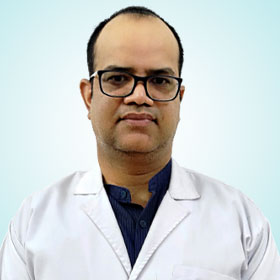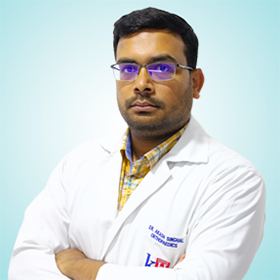List of Top Knee Replacement Surgery doctors near by
List of Top Hip Replacement Surgery doctors near by
List of Top Shoulder Replacement Surgery doctors near by
List of Top Sports Injury Treatment doctors near by
List of Top Total Knee Replacement doctors near by
List of Top Ankle Arthroscopy doctors near by
List of Top Anterior Cruciate Ligament (ACL) Surgery doctors near by
List of Top Pacemaker Implantation doctors near by
List of Top Intra-Aortic Balloon Pump (IABP) Therapy doctors near by
List of Top Balloon Valvuloplasty doctors near by
List of Top Automated Implantable Cardioverter Defibrillator (AICD) doctors near by
List of Top Angioplasty doctors near by
List of Top Robotic Knee Replacement Surgery doctors near by
Talk to our doctors
Knee Replacement Surgery
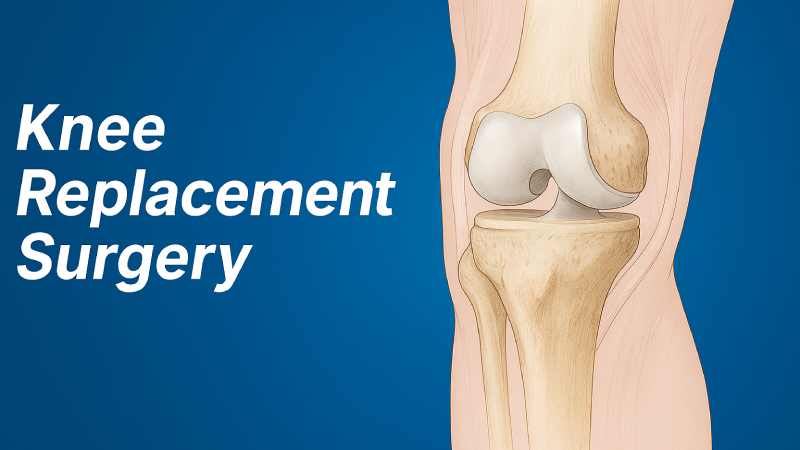
Knee replacement surgery, also known as knee arthroplasty, is a common orthopedic procedure performed to alleviate chronic knee pain and improve mobility in patients with severe joint conditions. This surgical procedure involves removing damaged cartilage and bone from the knee joint and replacing them with artificial components. At Kailash Hospital, we offer comprehensive knee replacement solutions using state-of-the-art technology to ensure the highest standard of care for patients.
What is Knee Replacement Surgery?
Knee replacement surgery is a medical procedure in which parts of the damaged knee joint are replaced with a prosthesis. The artificial joint is made of metal alloys, high-grade plastics, or polymers, which mimic the function of a natural knee. Various types of knee replacement surgeries exist, such as partial knee replacement, which involves replacing only a portion of the knee joint, and full or total knee replacement surgery, which involves replacing the entire joint.
When is Knee Replacement Surgery Recommended?
Knee replacement is generally recommended for patients who experience persistent knee pain and stiffness, despite trying non-surgical treatments like physical therapy, medications, and lifestyle changes. Knee replacement surgery may be required for common conditions such as:
- Osteoarthritis: The most common reason for knee surgery, where the cartilage that cushions the joint gradually wears away.
- Rheumatoid Arthritis: A chronic inflammatory condition affecting the lining of the joints.
- Traumatic Knee Injuries: Such as fractures or ligament tears that result in significant joint damage.
- Post-Traumatic Arthritis: Arthritis that arises following a severe knee injury.
Types of Knee Replacement Procedures
At Kailash Hospital, we offer different types of knee replacement procedures tailored to the patient's condition:
- Partial Knee Replacement: This surgery replaces only the damaged section of the knee joint, preserving the healthy parts. It is suitable for patients with localized arthritis.
- Total Knee Replacement Surgery: Involves replacing the entire knee joint, making it ideal for patients with extensive arthritis or damage.
- Revision Knee Replacement: A secondary surgery performed to replace a worn-out or damaged prosthesis from a previous knee replacement operation.
The Knee Replacement Surgery Procedure
Pre-Operative Evaluation
Before scheduling knee replacement surgery, patients undergo a thorough evaluation to assess their overall health and the severity of their knee condition. This evaluation may include:
- Medical History Review: To identify any underlying health conditions that could affect the surgery.
- Physical Examination: Assessing the range of motion, stability, and strength of the knee joint.
- Imaging Tests: X-rays or MRI scans are performed to provide a detailed view of the joint structure.
The Surgical Process
Knee replacement surgery typically involves the following steps:
- Anesthesia: The procedure is performed under general anesthesia or regional anesthesia (spinal or epidural) to ensure the patient's comfort.
- Incision: The orthopedic surgeon makes an incision on the front of the knee to access the joint.
- Bone and Cartilage Removal: Damaged portions of bone and cartilage are carefully removed from the femur, tibia, and kneecap.
- Implant Placement: The artificial components are then secured in place, and the joint is tested for proper movement and alignment.
- Closure: The incision is closed with sutures or staples, and a bandage is applied.
Post-Surgical Care and Rehabilitation
After knee replacement surgery, proper rehabilitation is essential for a successful recovery. At Kailash Hospital, our multidisciplinary team provides personalized post-operative care, including:
- Physical Therapy: To regain strength, flexibility, and range of motion in the knee.
- Pain Management: Medications may be prescribed to manage post-surgical discomfort.
- Lifestyle Adjustments: Patients may be advised to avoid high-impact activities until they fully recover.
Recovery Timeline
While recovery time varies, most patients can expect the following timeline:
- First Few Days: Patients may need to use a walker or crutches. Rehabilitation exercises typically start within 24 hours.
- Weeks 3-6: Increased mobility and gradual return to daily activities.
- 3 Months and Beyond: Most patients achieve near-full recovery and can resume low-impact sports and exercise.
Factors Affecting Knee Replacement Surgery Cost
The knee replacement surgery cost can be influenced by various factors, such as:
- Type of Procedure: Costs differ between partial knee replacement and full knee replacement surgery.
- Surgeon's Experience: More experienced orthopedic surgeons may charge higher fees.
- Hospital Charges: The cost may vary based on the healthcare facility's location and the duration of the hospital stay.
- Prosthesis Type: The quality and material of the prosthetic components can impact the overall cost.
- Post-Operative Care: Expenses related to rehabilitation and follow-up visits should also be considered.
At Kailash Hospital, we offer transparent pricing and financing options to make the procedure accessible for everyone.
Why Choose Kailash Hospital for Knee Replacement Surgery?
Choosing the right hospital for knee replacement surgery is crucial for achieving successful outcomes. Kailash Hospital is recognized as a leading healthcare provider for orthopedic treatments, with several key advantages:
- Experienced Surgeons: Our orthopedic team includes some of the best specialists in the field, skilled in performing both partial and total knee replacement surgeries.
- Advanced Technology: We use the latest surgical techniques and high-quality prosthetic materials to enhance patient outcomes.
- Comprehensive Rehabilitation Programs: Our dedicated rehabilitation team works with patients to develop individualized recovery plans.
- Patient-Centric Care: We prioritize patient comfort and satisfaction, ensuring that each individual receives compassionate and personalized care.
- Convenient Location: For those searching for a "knee replacement doctor near me" or "knee replacement surgeon near me," Kailash Hospital offers accessible services in Noida and surrounding areas.
Preparing for Your Knee Replacement Consultation
When visiting Kailash Hospital for a consultation, patients are advised to:
- Bring Medical Records: Previous imaging studies, surgical history, and medication lists can help the surgeon plan the procedure.
- Ask Questions: Feel free to inquire about the surgery, including risks, benefits, and expected recovery time.
- Discuss Goals: Share your expectations for the surgery, whether they involve reducing pain, improving mobility, or returning to specific activities.
Knee Replacement Surgery Success Rates and Long-Term Outcomes
Knee replacement surgery has a high success rate, with over 90% of patients experiencing significant pain relief and improved joint function. The lifespan of a knee prosthesis can vary, but it often lasts 15-20 years or more. Factors contributing to long-term success include:
- Maintaining a Healthy Weight: Reducing stress on the knee joint helps prolong the life of the prosthetic.
- Staying Active: Engaging in low-impact exercises like swimming or cycling can keep the joint flexible and strong.
- Regular Follow-Ups: Routine check-ups at Kailash Hospital can help monitor the condition of the knee replacement.
Knee replacement surgery can be a life-changing procedure for individuals struggling with chronic knee pain and mobility limitations. At Kailash Hospital, we are committed to providing high-quality knee surgery options, including partial and full knee replacement, tailored to meet the needs of each patient. Our experienced team, advanced technology, and comprehensive rehabilitation programs make us a trusted choice for knee replacement surgery in Noida and beyond.
If you are considering knee replacement or need advice on knee health, contact Kailash Hospital today. Our team of specialists is here to guide you through every step, from consultation to post-surgery care, helping you achieve a pain-free and active lifestyle. Whether you are looking for a "knee replacement surgeon near me" or seeking information on knee replacement surgery cost, we are here to assist you in making an informed decision.
Hip Replacement Surgery
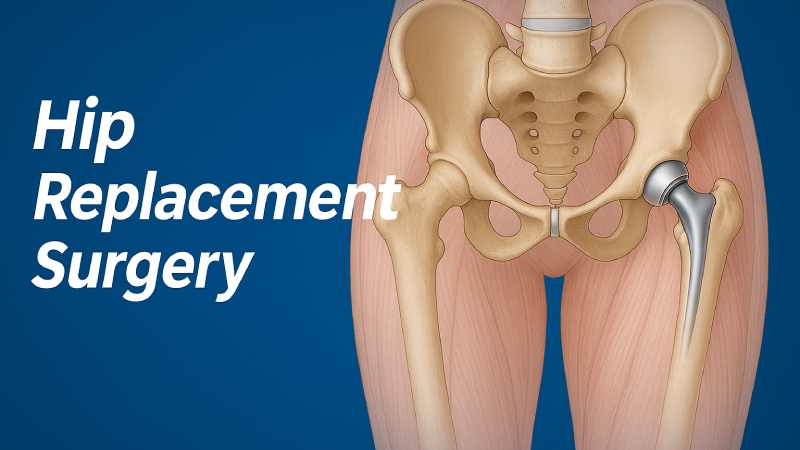
Hip replacement surgery, medically referred to as total hip arthroplasty, is a widely performed procedure aimed at replacing a damaged or worn-out hip joint with an artificial prosthesis. This surgery is often considered for individuals experiencing severe hip pain, stiffness, or loss of function due to arthritis, fractures, or other degenerative joint conditions. By restoring the structure and function of the hip, the procedure can significantly enhance a patient's quality of life.
At Kailash Hospital, we provide advanced hip replacement surgeries performed by skilled orthopedic surgeons. With state-of-the-art technology and a patient-centered approach, Kailash Hospital is committed to ensuring optimal outcomes for those in need of hip joint replacement.
Who is a Candidate for Hip Replacement Surgery?
Individuals who suffer from debilitating hip pain and limited movement may be considered for hip replacement surgery. Candidates typically include:
- Osteoarthritis Patients: Those experiencing significant joint damage due to osteoarthritis, which results in the wearing down of cartilage, may benefit from hip replacement.
- Rheumatoid Arthritis Patients: An autoimmune disorder that causes chronic inflammation, rheumatoid arthritis can lead to joint destruction, making surgery necessary.
- Avascular Necrosis Patients: This condition occurs when the blood supply to the hip bone is disrupted, causing bone tissue to die. Total hip joint replacement may be needed in advanced cases.
- Trauma or Fracture Patients: Hip fractures, especially in elderly individuals, can cause severe damage to the hip joint, requiring surgical intervention.
Hip replacement may also be recommended when non-surgical treatments such as physical therapy, medications, or lifestyle modifications fail to provide adequate relief.
Types of Hip Replacement Surgery
Different types of hip replacement procedures are available, depending on the patient's condition and preferences:
- Total Hip Arthroplasty (THA): This involves replacing both the ball (femoral head) and the socket (acetabulum) of the hip joint with prosthetic components. It is the most common form of hip replacement surgery.
- Partial Hip Replacement: In this procedure, only the femoral head is replaced, leaving the natural acetabulum intact. It is often performed in cases of hip fractures.
- Hip Resurfacing: Instead of replacing the entire femoral head, the damaged surfaces of the bone are capped with a smooth metal covering. This option is generally recommended for younger, more active patients.
Benefits of Hip Replacement Surgery
There are several advantages associated with hip replacement surgery:
- Pain Reduction: The primary goal is to alleviate chronic hip pain that interferes with daily life, enabling individuals to resume normal activities.
- Improved Mobility and Function: Replacing the damaged joint restores a greater range of motion and allows for easier movement.
- Enhanced Quality of Life: Patients can participate in activities that were previously limited by hip discomfort.
- Long-Lasting Solution: Modern hip prostheses are designed to last for many years, often exceeding 20 years with proper care.
Hip Replacement Surgery Process
At Kailash Hospital, hip replacement surgery involves a systematic approach, ensuring patient safety and optimal recovery:
- Pre-Surgical Evaluation: The process begins with a thorough assessment that includes a physical examination, imaging tests (X-rays or MRI), and a review of the patient's medical history.
- Anesthesia: The surgery is usually performed under general or spinal anesthesia, keeping the patient pain-free during the procedure.
- Incision and Joint Exposure: A surgical incision is made along the hip to access the damaged joint. The surgeon carefully removes the affected bone and cartilage.
- Implantation of Prosthetic Components: The artificial components, which may be made from metal, ceramic, or plastic, are positioned in place. The new ball-and-socket joint is tested for stability and range of motion.
- Closure and Dressing: The incision is closed with sutures or staples, and a sterile dressing is applied to the wound site.
Diagnosis Before Hip Replacement Surgery
A comprehensive diagnosis is necessary before undergoing hip replacement surgery at Kailash Hospital:
- Physical Assessment: An orthopedic specialist will evaluate the range of motion, pain level, and overall joint function.
- Imaging Studies: X-rays, CT scans, or MRI may be used to determine the extent of joint damage and guide the choice of surgical technique.
- Laboratory Tests: Routine blood work and other pre-operative tests ensure that the patient is in good health and suitable for surgery.
Hip Replacement Surgery Aftercare
After the surgery, following an appropriate aftercare regimen is essential for a successful recovery:
- Hospital Stay: Patients may be required to stay in the hospital for a few days for monitoring and initial rehabilitation.
- Pain Management: Pain relief medication is provided, and the patient may use crutches or a walker for support.
- Physical Therapy: Rehabilitation is crucial to regaining strength and mobility in the hip. A physical therapist will design a personalized program to assist with walking and other movements.
- Follow-Up Appointments: Regular visits to the orthopedic doctor ensure the recovery is progressing as expected, and adjustments can be made if necessary.
Hip Replacement Surgery Cost Considerations
The cost of hip replacement surgery can vary depending on several factors:
- Type of Prosthesis: Different materials used in prosthetic joints (e.g., metal-on-plastic, ceramic-on-ceramic) can influence the overall cost.
- Hospital Charges: Fees for surgical facilities, the length of stay, and any additional services provided by Kailash Hospital will impact the total expense.
- Surgeon’s Experience: The expertise of the hip replacement surgeon may also play a role in determining the cost.
For those searching for "hip replacement doctors near me" or "hip replacement surgeon near me," Kailash Hospital in Noida offers a comprehensive solution with a team of highly qualified orthopedic specialists.
Recovery Timeline for Hip Replacement Surgery
The recovery time for hip replacement surgery varies, but here is a general guide:
- First Few Days: The initial days involve pain management and gradual mobilization, usually with the help of a walker.
- 2-6 Weeks: As healing progresses, the patient will engage in physical therapy exercises to improve hip strength and flexibility.
- 3-6 Months: Many patients can resume low-impact activities such as swimming or cycling during this period, but heavy lifting and strenuous exercises should be avoided.
- 6-12 Months: Full recovery, including the resumption of most daily activities, is often achieved within a year.
Potential Risks and Complications of Hip Replacement Surgery
While hip replacement is generally safe, some risks include:
- Infection: In rare cases, surgical site infection may occur, necessitating additional treatment.
- Blood Clots: Blood-thinning medications may be prescribed to reduce the risk of clot formation.
- Dislocation: The new hip joint may occasionally dislocate, particularly during the early recovery stages.
- Leg Length Discrepancy: Some patients may experience a slight difference in leg length, which can be addressed with physical therapy.
Choosing Kailash Hospital for Hip Replacement Surgery
Kailash Hospital in Noida is a leading provider of hip replacement surgery, offering patients access to top-notch orthopedic care. With a team of experienced surgeons, state-of-the-art facilities, and a patient-focused approach, Kailash Hospital ensures that every aspect of care is addressed, from diagnosis to post-surgical rehabilitation. For those looking for "hip replacement doctors near me" or "hip replacement surgeon near me," Kailash Hospital provides a reliable and high-quality solution.
Hip replacement surgery is an effective treatment for individuals suffering from chronic hip pain and reduced mobility. It offers numerous benefits, such as pain relief, improved function, and an enhanced quality of life. At Kailash Hospital, patients receive the best possible care, with access to expert surgeons and comprehensive rehabilitation services. Whether it's a total hip joint replacement or a more specific hip resurfacing procedure, the dedicated team at Kailash Hospital is committed to helping patients return to a pain-free and active lifestyle.
Shoulder Replacement Surgery

Shoulder replacement surgery, also known as shoulder arthroplasty, is a medical procedure designed to alleviate pain and restore function in patients with severe shoulder joint damage. This surgery involves replacing the damaged parts of the shoulder joint with artificial components called prostheses, allowing patients to regain mobility and lead a more comfortable life. The procedure is often recommended when non-surgical treatments like medication, physical therapy, or lifestyle modifications have failed to provide relief.
Kailash Hospital offers advanced shoulder replacement surgery, performed by experienced orthopedic surgeons who utilize the latest techniques and technologies to ensure the best possible outcomes for patients.
Who is a Candidate for Shoulder Replacement Surgery?
Patients suffering from conditions such as severe osteoarthritis, rheumatoid arthritis, post-traumatic arthritis, or marked rotator cuff tear arthropathy may be candidates for shoulder replacement surgery. Individuals with a history of shoulder fractures that have not healed properly, or those experiencing significant pain and loss of shoulder function, may also benefit from the procedure. In general, candidates are those who find daily activities such as dressing, lifting, or even resting at night challenging due to chronic shoulder pain and limited movement.
Types of Shoulder Replacement Surgeries
There are several types of shoulder replacement surgeries that may be recommended based on the patient's specific condition and needs:
- Total Shoulder Replacement: This procedure involves replacing both the ball (humeral head) and socket (glenoid) parts of the shoulder joint with prosthetic components. It is the most common form of shoulder arthroplasty, typically used for patients with osteoarthritis or other joint degenerative conditions.
- Partial Shoulder Replacement (Hemiarthroplasty): In this type, only the humeral head (ball) is replaced, while the natural socket is left intact. This approach is often suitable for patients with arthritis confined to the humeral head.
- Reverse Total Shoulder Replacement: In reverse shoulder replacement, the position of the ball and socket components is switched. This technique is ideal for patients with large rotator cuff tears and arthritis, as it relies on different muscles to lift the arm, providing a more stable joint.
Benefits of Shoulder Replacement Surgery
There are numerous benefits associated with undergoing shoulder replacement surgery, including:
- Pain Relief: The primary goal is to significantly reduce or eliminate shoulder pain, allowing patients to engage in daily activities without discomfort.
- Improved Mobility: Replacing the damaged joint restores the shoulder's range of motion, enabling greater function.
- Enhanced Quality of Life: Pain-free movement and restored shoulder function can lead to a more active lifestyle, improving the overall quality of life.
- Long-Lasting Results: Modern prosthetic designs and surgical techniques have improved the longevity of shoulder replacement, often lasting 15-20 years or more.
Shoulder Replacement Surgery Process
The procedure typically follows these steps:
- Pre-Operative Preparation: Patients undergo a thorough evaluation at Kailash Hospital, including a physical exam, imaging studies such as X-rays or MRIs, and a review of their medical history. This helps the surgeon determine the most suitable type of shoulder replacement.
- Anesthesia: The surgery is usually performed under general anesthesia, ensuring the patient is asleep and comfortable throughout the procedure.
- Incision and Joint Exposure: An incision is made over the shoulder, and the muscles and tendons are carefully moved aside to expose the damaged joint.
- Removal of Damaged Tissue: The surgeon removes the damaged portions of the humeral head and glenoid (socket), preparing the area for the prosthetic components.
- Implanting the Prosthesis: The artificial components are fitted into place, and the joint is tested for stability and range of motion. The prostheses are often cemented in place or secured using a press-fit technique.
- Closure: The incision is closed with sutures or staples, and a sterile bandage is applied to the surgical site.
Diagnosis Before Shoulder Replacement Surgery
Before proceeding with shoulder replacement surgery, patients at Kailash Hospital will undergo comprehensive diagnostic evaluations to confirm the need for the procedure and to plan the surgical approach. These evaluations may include:
- Physical Examination: The orthopedic doctor will assess the shoulder’s range of motion, pain level, and muscle strength.
- Imaging Tests: X-rays, MRIs, or CT scans may be performed to visualize the extent of joint damage and guide the choice of surgical technique.
- Blood Tests and Medical Evaluation: Routine blood tests and a review of the patient’s medical history help identify any underlying health issues that could affect surgery.
Shoulder Replacement Surgery Aftercare
After surgery, proper aftercare is essential for a successful recovery:
- Hospital Stay: Patients may need to stay in the hospital for 1-2 days, depending on their condition and the extent of the surgery.
- Pain Management: Pain medication will be provided to manage post-surgical discomfort, and the shoulder may be immobilized in a sling to promote healing.
- Physical Therapy: Rehabilitation typically begins shortly after surgery, focusing on gentle exercises to restore shoulder function. Gradual progression to strengthening exercises helps regain full mobility.
- Monitoring and Follow-Up: Regular follow-up visits to the orthopedic doctor will be scheduled to monitor healing, assess progress, and make necessary adjustments to the recovery plan.
Factors Influencing Shoulder Replacement Surgery Cost
The cost of shoulder replacement surgery can vary depending on several factors, including:
- Type of Surgery: Total shoulder replacement may be more expensive than partial or reverse shoulder replacement due to the complexity of the procedure and the type of prosthesis used.
- Hospital Charges: Facilities like Kailash Hospital provide a range of packages to cater to different patient needs, including room type, length of hospital stay, and additional services.
- Surgeon’s Fees: The experience and expertise of the shoulder replacement surgeon can also influence the overall cost.
Patients seeking "shoulder replacement surgery cost" information should consult Kailash Hospital to get a personalized estimate based on their specific requirements.
What to Expect During the Recovery Period
The recovery period following shoulder replacement surgery can vary based on the individual’s health, the type of surgery, and the level of rehabilitation effort. Generally:
- First Few Weeks: Expect some swelling and pain, which will gradually decrease. The arm will be in a sling for support.
- 1-3 Months: As physical therapy progresses, mobility and strength improve. Many patients can resume light activities within this period.
- 3-6 Months: By this time, most patients achieve a substantial range of motion and return to daily activities without limitations.
- Full Recovery: It may take 6-12 months for a complete recovery, especially for patients undergoing reverse shoulder replacement or dealing with complex cases.
Complications and Risks Associated with Shoulder Surgery
Although shoulder replacement surgery is generally safe, potential risks include:
- Infection: Though rare, surgical site infections can occur, requiring prompt treatment.
- Implant Loosening: Over time, the prosthetic components may loosen, potentially needing revision surgery.
- Nerve or Blood Vessel Damage: While uncommon, injury to nearby nerves or blood vessels can happen during surgery.
- Stiffness or Limited Range of Motion: Post-operative stiffness may occur, particularly if physical therapy is not followed diligently.
Why Choose Kailash Hospital for Shoulder Replacement Surgery?
Kailash Hospital is renowned for offering top-quality orthopedic care, with a team of skilled shoulder replacement surgeons who are dedicated to providing personalized treatment plans. The hospital is equipped with state-of-the-art facilities and a compassionate approach, ensuring each patient receives comprehensive care from diagnosis through recovery. For those searching for "shoulder replacement doctors near me" or "shoulder replacement surgeon near me," Kailash Hospital in Noida is an excellent choice.
In conclusion, shoulder replacement surgery is a highly effective solution for individuals suffering from severe shoulder pain and joint dysfunction. With the right care and rehabilitation, it can significantly improve the quality of life, allowing patients to resume daily activities without discomfort. Choosing an experienced hospital like Kailash Hospital ensures that patients receive the best possible care from skilled professionals.
Sports Injury Treatment
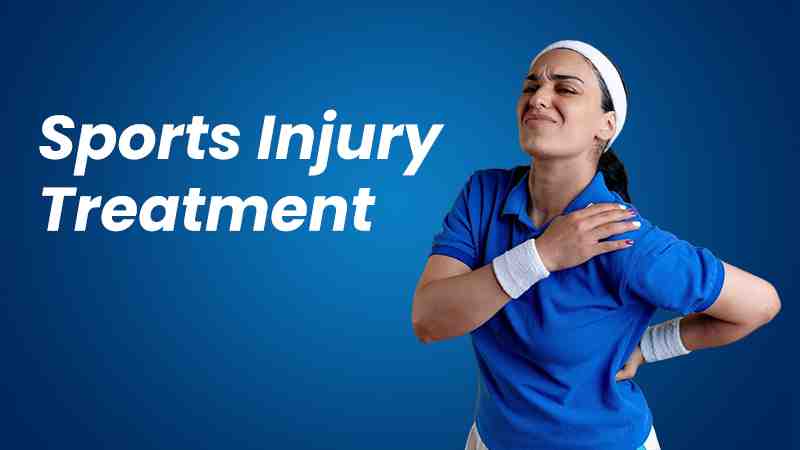
Sports injuries are a prevalent risk for anyone involved in physical activities, from elite athletes to recreational participants. The severity of these injuries can range from minor strains and sprains to more serious issues such as fractures and torn ligaments. Timely and appropriate treatment is vital for a full recovery and the prevention of long-term complications. At Kailash Hospital, sports injury specialists utilize advanced techniques and personalized rehabilitation plans to help patients recover their strength and resume their active lifestyles as safely and quickly as possible.
Who Might Need Sports Injury Treatment?
A variety of individuals may require sports injury treatment, including:
- Athletes: Both professional and amateur athletes are susceptible to injuries while participating in sports.
- Active Adults and Teenagers: Regular participants in activities such as running, cycling, or gym workouts may experience joint pain, muscle strains, or similar issues.
- Recreational Sports Enthusiasts: Those who play sports casually, like soccer, basketball, or tennis, may sustain injuries during their activities.
Benefits of Sports Injury Treatment
Prompt and suitable management of sports injuries offers several advantages:
- Accelerated Recovery: Early diagnosis and treatment can shorten recovery time, allowing athletes to resume their activities sooner.
- Pain Management: Proper treatment helps alleviate pain and discomfort, enhancing the patient’s quality of life.
- Prevention of Complications: Addressing injuries early reduces the risk of further damage and complications.
- Customized Rehabilitation: Tailored rehabilitation programs restore strength, flexibility, and endurance in the injured area.
Common Types of Sports Injuries
Kailash Hospital’s orthopedic team specializes in treating various sports-related injuries, including:
1. Sprains and Strains
- Sprains: Ligament injuries resulting from joint twisting or overstretching, often affecting the ankle, knee, or wrist.
- Strains: Injuries to muscles or tendons due to overstretching or tearing, frequently occurring in the hamstrings, quadriceps, or lower back.
2. Fractures
- Bone Fractures: Breaks in bones caused by high-impact collisions, falls, or direct trauma, commonly affecting the collarbone, wrist, or leg.
3. Dislocations
- Joint Dislocations: Occur when bones are forced out of their normal position, typically in the shoulder, knee.
4. Tendon Injuries
- Tendonitis: Inflammation from overuse, often affecting the Achilles tendon or rotator cuff.
- Tendon Ruptures: Severe tears requiring surgical repair.
5. Knee Ligament Tears
- ACL/PCL Tears: Common knee injuries in athletes, often necessitating surgical reconstruction, Keyhole Surgery (Arthroscopic Surgeries)
- MCL and LCL Tears: Involvement of the medial or lateral collateral ligaments. Higher grade/complete injury may need surgical treatment.
Diagnosis before Sports Injury Treatment
Accurate diagnosis is essential for an effective treatment plan. At Kailash Hospital, sports injury specialists in Noida use various diagnostic techniques to assess the injury’s severity:
- Physical Examination: Evaluates swelling, bruising, and mobility limitations.
- Imaging Tests: X-rays, MRIs, scans provide detailed views to identify fractures or soft tissue damage or ligaments.
- Functional Assessment: Assesses range of motion, strength, and stability to determine the injury’s impact.
Sports Injury Treatment Options at Kailash Hospital
Treatment depends on the type and severity of the injury. Kailash Hospital offers a range of options, from conservative approaches to surgical interventions:
1. Conservative Management
- Rest, Ice, Compression, and Elevation (RICE): Standard care for minor injuries to reduce inflammation and pain.
- Physical Therapy: Personalized programs to restore flexibility, strength, and function.
2. Injections
- Corticosteroid Injections: Used to reduce inflammation in conditions like tendonitis or bursitis.
- Platelet-Rich Plasma (PRP) Therapy: Platelet-rich plasma therapy accelerates healing using the patient's blood components.
3. Surgical Treatment
- Arthroscopic Surgery: Minimally invasive keyhole procedures for repairing or reconstruction torn ligaments, tendons, or cartilage. Especially ACL/PCL Knee, Rotator cuff & bankart tear for recurrence shoulder & dislocation surgery.
- Open Surgery: Required for complex fractures, dislocations, or complete tendon ruptures.
Post-Surgical Rehabilitation and Recovery
Rehabilitation is crucial for sports injury management. Kailash Hospital provides comprehensive recovery plans, including:
- Physical Therapy Sessions: To rebuild strength, mobility, and endurance.
- Home Exercise Program: Customized exercises to aid healing and prevent re-injury.
- Gradual Return to Activity: Step-by-step guidance for safely resuming sports.
Advantages of Choosing Kailash Hospital for Sports Injury Treatment
Kailash Hospital is a leading choice for sports injury care in Noida, offering:
- Experienced Orthopedic Team: A skilled team experienced in treating athletes and active individuals.
- Cutting-Edge Technology: State-of-the-art diagnostic tools and surgical facilities for accurate assessment and treatment.
- Comprehensive Care: Comprehensive services from diagnosis to rehabilitation for all sports injuries.
- Convenient Location: Conveniently located for those searching for "sports injury treatment near me" or "sports injury doctor near me".
Recovery Time for Different Sports Injuries
Recovery durations vary based on injury type and severity:
- Minor Sprains and Strains: Typically heal in 1-3 weeks with appropriate rest and therapy.
- Fractures: Healing time ranges from 6-8 weeks, depending on the bone and treatment method.
- Surgical Repair of Ligaments or Tendons: May require 3-6 months of rehabilitation.
Possible Complications and Preventive Measures
While sports injury treatments are effective, complications can occur:
- Re-Injury: Premature return to sports may cause further harm.
- Chronic Pain or Stiffness: Inadequate healing or lack of rehabilitation could lead to lasting problems.
- Surgical Risks: Potential risks include infection, bleeding, or nerve damage.
Preventive strategies include:
- Warm-Up and Stretching: Proper routines reduce the risk of muscle and joint injuries.
- Strength and Conditioning Programs: Targeted training improves muscle balance and joint stability.
- Use of Protective Gear: Helmets, braces, and pads help prevent injuries during high-risk activities.
Why Choose Kailash Hospital for Sports Injury Treatment?
Kailash Hospital offers top-quality sports injury care in Noida, making it a preferred choice:
- Dedicated Sports Injury Centre: Equipped with modern facilities for comprehensive care.
- Expert Sports Injury Doctors: Specialists with extensive experience in sports injury surgery.
- Comprehensive Rehabilitation Programs: Tailored plans ensure a smooth and efficient recovery.
- Convenient Access: If you are searching for "sports injury surgeon near me" or "sports injury treatment near me," Kailash Hospital's location makes it convenient for patients in the region.
Sports injuries can significantly impact an athlete’s performance, making prompt and appropriate care essential. Kailash Hospital’s specialists provide comprehensive services, from diagnosis and non-surgical options to advanced surgeries and rehabilitation. Focusing on individualized treatment plans, the hospital ensures patients recover fully and return to their active lifestyles safely. Whether managing a minor injury or performing complex surgical interventions, Kailash Hospital’s experienced team are committed to delivering the highest standard of care for sports injury treatment.
Total Knee Replacement

Total knee replacement surgery, also known as total knee arthroplasty, is a procedure aimed at alleviating pain and restoring function in severely damaged knee joints. Typically recommended for individuals with chronic knee conditions such as osteoarthritis, rheumatoid arthritis, or post-traumatic arthritis, this surgery involves replacing the damaged knee components with artificial implants. At Kailash Hospital, the orthopedic specialists are skilled in providing comprehensive TKR treatment, ensuring an optimal recovery for patients and a return to a pain-free lifestyle. TKR ensures good walking which is a must for controlling diabetes, hypertension, obesity and cardiac health.
What is Total Knee Replacement Surgery?
Total knee replacement surgery is a procedure where the damaged portions of the knee joint are replaced with prosthetic components made of metal and plastic. The aim is to mimic the natural motion of the knee, correct deformity and provide long-term relief from pain. The surgery primarily addresses issues with the cartilage, bone, and connective tissues that are significantly damaged, resulting in painful and difficult movements.
The key components replaced during TKR surgery include:
- Femoral Component: The lower end of the thigh bone.
- Tibial Component: The upper end of the shin bone.
- Patellar Component: The back surface of the kneecap.
Signs You May Need Total Knee Replacement Surgery
Individuals experiencing any of the following symptoms may be candidates for total knee replacement surgery:
- Severe Knee Pain: Pain that limits daily activities such as walking, climbing stairs, or even standing.
- Swelling and Stiffness: Persistent swelling and loss of flexibility in the knee joint.
- Decreased Range of Motion: Difficulty fully straightening or bending the knee.
- No Relief from Non-Surgical Treatments: When treatments such as medication, physical therapy, or injections fail to provide significant relief.
- Knee Deformity: A noticeable inward or outward bowing of the leg.
Total Knee Replacement Surgery at Kailash Hospital
At Kailash Hospital, our team of experienced orthopedic surgeons performs TKR surgery with precision, aiming to deliver successful outcomes for each patient. Here is an overview of the comprehensive approach taken for total knee replacement surgery:
1. Pre-Surgical Evaluation
Before recommending total knee replacement, the orthopedic team at Kailash Hospital conducts a thorough assessment, which includes:
- Medical History Review: Understanding the patient’s medical background, including previous surgeries or treatments. Majority of patients requiring TKR are osteoarthritis patients (55yrs+) but some may need TKR at younger age too, like in case of rheumatoid arthritis and post traumatic arthritis.
- Physical Examination: Evaluating the movement and condition of the knee joint.
- Imaging Tests: X-rays, scanograms, CT Scans and MRI scans help determine the extent of the knee damage and guide the surgical plan.
2. The TKR Surgery Procedure
Total knee replacement surgery generally involves the following steps:
- Anesthesia: The patient is given either general anesthesia (to sleep through the procedure) or spinal anesthesia (to numb the lower body).
- Incision: A small incision is made over the front of the knee to access the joint.
- Resurfacing the Joint: Damaged bone and cartilage are removed from the thigh bone, shinbone, and kneecap.
- Implanting Prosthetics: The surgeon fits the artificial components to resurface the knee, ensuring they are aligned to mimic the natural motion.
- Closing the Incision: The incision is closed, and the knee is bandaged.
3. Post-Surgical Care
After the surgery, patients are monitored closely to ensure a smooth recovery. Kailash Hospital provides a personalized rehabilitation program (home care) that includes:
- Pain Management: Medications are prescribed to control discomfort.
- Physical Therapy: Guided exercises help restore movement and strength to the knee.
- Wound Care: Patients are given instructions on keeping the surgical site clean and dry.
- Follow-Up Visits: Few check-ups with the joint replacement surgeon to monitor recovery.
TKR Treatment Recovery Timeline
The recovery period after TKR treatment can vary, but patients can generally expect the following stages:
- First 3-4 Days: Patients are encouraged by physiotherapist to begin moving the knee, walk with walker, can go to toilet.
- Weeks 1-3: Continued physical therapy, focusing on increasing knee mobility, walk and strength, leave walker, hold stick, practice stair climbing.
- Weeks 3-6: Many individuals can resume normal daily activities, though strenuous exercise is still limited. Usually can freely have long walk without stick and climb atleast 2 floors.
- At 3 Months: Most patients regain full strength and flexibility, with no discomfort.
Factors Influencing Total Knee Replacement Surgery Cost
Majority of TKR are performed at reasonable, standard package system. Sometimes cost of total knee replacement surgery can vary depending on various factors:
- Severity of the Knee Damage: More complex cases may require additional surgical steps.
- Type of Implant Used: There are different types of knee implants, and the choice can affect the overall cost.
- Hospital Stay Duration: The length of hospitalization required for post-operative care.
- Rehabilitation Requirements: Extensive physiotherapy may increase the overall expenses.
At Kailash Hospital, we strive to provide high-quality medical care with transparent pricing, ensuring that patients are pre-informed about the costs associated with their TKR surgery.
Choosing the Right Surgeon for TKR Surgery
Finding a qualified surgeon is critical for a successful outcome in TKR surgery. Patients often look for the "total knee replacement surgeon near me" or "total knee replacement doctor near me" to find accessible, quality orthopedic care. At Kailash Hospital, our orthopedic surgeons have years of experience in performing total knee replacement procedures, ensuring the best possible results for patients.
Risks and Complications of Total Knee Replacement Surgery
Like any surgical procedure, TKR surgery carries some risks, although incidence is very very low:
- Infection: The risk is minimized through sterile surgical techniques and post-operative care.
- Blood Clots: Medications and physical therapy help reduce the risk of clot formation.
- Nerve or Blood Vessel Injury: Although rare, precautions are taken to avoid any damage.
- Implant Loosening: In some cases, the prosthetic components may loosen over time. (aseptic loosening)
- Continued Pain or Stiffness: While most patients experience significant pain relief, some may continue to have residual symptoms.
Non-Surgical Alternatives to TKR Surgery
While total knee replacement is an effective solution for severe knee conditions, some patients may explore non-surgical alternatives before opting for surgery:
- Physical Therapy: Strengthening the muscles around the knee can alleviate pain.
- Medication: Anti-inflammatory drugs or pain relievers may offer temporary relief.
- Injections: Corticosteroid or hyaluronic acid injections can reduce pain and improve knee function.
- Lifestyle Changes: Weight loss or modifying activities can help manage symptoms.
Why Choose Kailash Hospital for Total Knee Replacement?
Kailash Hospital stands out as a top choice for total knee replacement surgery due to:
- Experienced Orthopedic Team: Our surgeons have expertise in performing complex knee surgeries.
- State-of-the-Art Facilities: The hospital is equipped with advanced surgical infrastructure and technology for precise and efficient procedures.
- Patient-Centered Care: We provide customized treatment plans tailored to individual needs.
- Comprehensive Post-Surgical Rehabilitation: Our rehabilitation programs are designed to ensure a quick and effective recovery.
Preventing the Need for Knee Surgery
While some cases of knee damage are inevitable due to age or genetics, there are preventive steps to minimize the risk of requiring TKR surgery:
- Maintain a Healthy Weight: Reducing stress on the knee joint can prevent cartilage wear.
- Stay Active: Regular exercise, including low-impact activities, helps keep the knee joints strong.
- Protect the Knees: Wear protective gear during sports and avoid high-risk activities that could result in injury.
- Treat Minor Injuries Promptly: Addressing knee pain or minor injuries can prevent further deterioration.
Total knee replacement surgery is a highly effective procedure for those suffering from severe knee pain and mobility issues. At Kailash Hospital, our skilled orthopedic team offers expert TKR treatment, helping patients achieve lasting relief and improved quality of life. Whether you are looking for a "total knee replacement doctor near me" or seeking advice on "total knee replacement surgery cost," Kailash Hospital is here to provide you with the best orthopedic care.
If you are struggling with knee issues or considering TKR surgery, don't hesitate to contact Kailash Hospital to schedule a consultation. Our dedicated team is ready to help you take the first step towards a pain-free life.
Ankle Arthroscopy
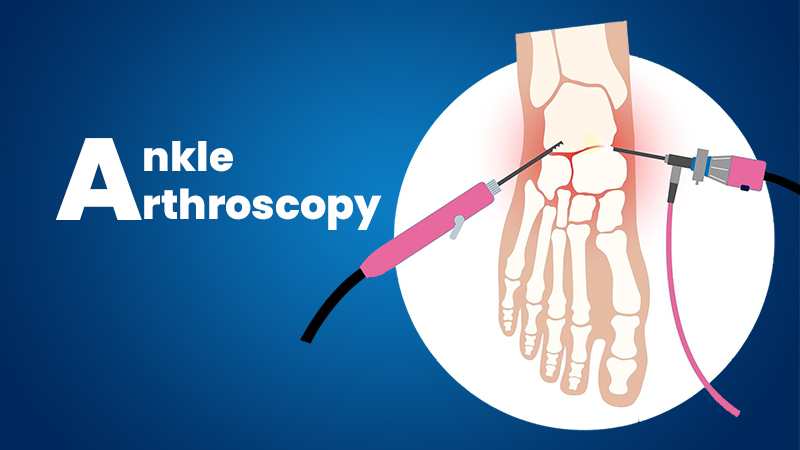
If you are suffering from persistent ankle pain due to arthritis or cartilage injuries, ankle arthroscopy is a minimally invasive surgical treatment option that can treat the problem. The procedure offers numerous benefits over traditional surgery. Being minimally invasive, ankle arthroscopy can lead to quicker recovery, less scarring, and fewer complications compared to open surgery.
Our team at Kailash Hospital utilizes the latest technology and procedures to treat ankle issues. Our ability to treat complex conditions with a holistic approach gives our patients the best possible outcome. Depending on the severity of the condition, our surgeons will determine if you qualify as a candidate.
What is Ankle Arthroscopy?
Ankle arthroscopy is performed for the surgical assessment and treatment of various ankle conditions. Arthroscopic ankle surgery is a procedure that uses a camera called an arthroscope and small surgical tools to operate in and around the ankle joint through small incisions. The minimally invasive surgical procedure allows our surgeons to visualize the inside of the ankle joint and assess and repair or remove damaged tissues to alleviate pain and improve overall function.
From addressing ankle fractures and ligament injuries to treating conditions like arthritis and cartilage damage, ankle arthroscopy offers a comprehensive approach to managing ankle problems with minimal tissue disruption.
When is Ankle Arthroscopy recommended?
Not all ankle conditions can be effectively treated with this minimally invasive procedure. You might be a suitable candidate for the procedure if you suffer from the following conditions:
- Ankle arthritis: Arthritis in the ankle can cause pain, swelling and limited range of motion.
- Ligament tears: A ligament is a band of tissue that holds bones together. If the ligament is torn or damaged, it can cause pain and swelling.
- Instability: Weakened or damaged ligaments can lead to ankle sprains and joint deterioration, making it difficult to securely stand or move.
- Ankle impingement: If tissues in or surrounding your ankle are overused, they can become swollen and sore, making it hard to move the joint.
- Cartilage injuries: Damage to the cartilage in the ankle can cause pain and limited range of motion.
- Loose fragments: Loose fragments of bone or cartilage within the ankle joint can cause pain, swelling and impaired joint movement.
- Scar tissue: Excessive scar tissue within the ankle joint can lead to stiffness and reduced mobility.
Our Procedure
Ankle arthroscopy is typically performed as an outpatient procedure under local anesthesia with sedation. The procedure usually involves the following steps:
- Preoperative Evaluation: Our orthopedic surgeon performs a thorough evaluation before starting the procedure. This process includes discussing your medical history, symptoms, and current medications. Our doctor will perform a physical examination and tests like X-rays and possibly an MRI scan to assess the ankle joint and determine if ankle arthroscopy is the most suitable course of action.
- Preparation: Our surgeon will tell you if you need to avoid eating or drinking anything before the surgery. Anesthesia is generally administered to help you relax during the procedure.
- Surgery: Our surgeon will make one or two small incisions near the ankle joint. The arthroscope and other surgical instruments are introduced through these small incisions. The surgeon visualizes the joint on a monitor screen and performs the necessary procedure, which might involve removing or repairing any damaged tissue. After the completion of the procedure, the incisions are closed with stitches or small bandages. The entire process takes about 30 minutes – 1 hour.
Ankle Arthroscopy Recovery
Patients are generally discharged from the hospital the same day after surgery. Following the procedure, your ankle will be bandaged, and you might need to wear a splint or boot for a few weeks or longer to allow healing. You may need to use a walker or crutches to avoid putting pressure or weight on your ankle or foot.
Ankle surgery recovery time varies depending on the specific procedure performed and the person’s overall health. Most patients experience significant pain relief within a few days, but regaining full range of motion and strength can take a few weeks or months. The rehabilitation process usually involves:
- Pain Management: You will be prescribed pain medication to manage discomfort following the procedure.
- Physical Therapy: A personalized physical therapy program is crucial to regain full range of motion, strength, and function in your ankle. This will help restore stability and prevent future injuries.
- Follow-up Appointments: Regular follow-up appointments with our doctor are important to monitor your healing progress and address any concerns.
Navigating Ankle Treatment Options
In severe cases where the ankle joint is significantly damaged due to arthritis or other conditions, ankle replacement surgery might be a consideration. The procedure involves replacing the damaged joint surfaces with artificial components. While it offers pain relief and improved function, it's a more invasive surgery compared to ankle arthroscopy.
Ankle arthroscopy is becoming a standard procedure as surgeons can perform complex operations with minimal incisions and lower risks. The procedure is usually effective in treating ankle problems, offering benefits such as reduced pain, improved function and quicker recovery times compared with traditional procedures.
Discussing all treatment options with your doctor is crucial to determine the most suitable approach for your specific needs.
Benefits of ankle arthroscopy
Ankle arthroscopy provides a valuable tool for diagnosing and treating a variety of ankle conditions. Some of the benefits of the procedure are:
- Quick recovery time: Arthroscopic surgeries tend to heal faster than traditional open surgeries. Most people can return to normal activities within one or two weeks.
- Less scarring: Because of the small incisions, there is minimal damage to the surrounding tissue in the ankle joint.
- Reduced pain: Because the incision size is small, patients report less postoperative pain.
- Short hospital stay: As ankle arthroscopy is performed on an outpatient basis, it allows you to return home faster than you would be able to for traditional surgery.
- Low complication risks: The small incision and minimal damage to surrounding tissues prevent infection and other complications.
Possible complications of ankle arthroscopy
Like all surgical procedures, ankle arthroscopy recovery may come with potential complications. This includes:
- Severe ankle pain & stiffness: Pain and stiffness are common after the surgery, but some patients experience a long-term decrease in flexibility.
- Infection: Infections are rare, but can occur at the incision site or within the ankle joint.
- Blood vessels or nerve damage: The procedure may damage the blood vessels or nerves surrounding the ankle joint. This damage can lead to bleeding, numbness, tingling or pain in the ankle.
- Blood clot: Surgery increases the risk of blood clot formation in the vein in the leg.
- Reactions to anesthesia: Reactions to anesthesia can range from mild to severe complications such as nausea, sore throat, allergic reactions and respiratory or cardiovascular problems.
If you experience any of the symptoms, immediately consult our arthroscopic surgeon.
Why Choose Kailash Hospital?
If you are experiencing chronic ankle pain or ankle injury, consult our orthopedic surgeon at Kailash Hospital. We have top-notch specialists and advanced technology, ensuring high-quality treatment for our patients.
Our team can help diagnose the cause of your problems and determine if ankle arthroscopy is the right course of action for you. We are passionate about giving our patients a positive experience and excellent clinical outcomes.
Anterior Cruciate Ligament (ACL) Surgery
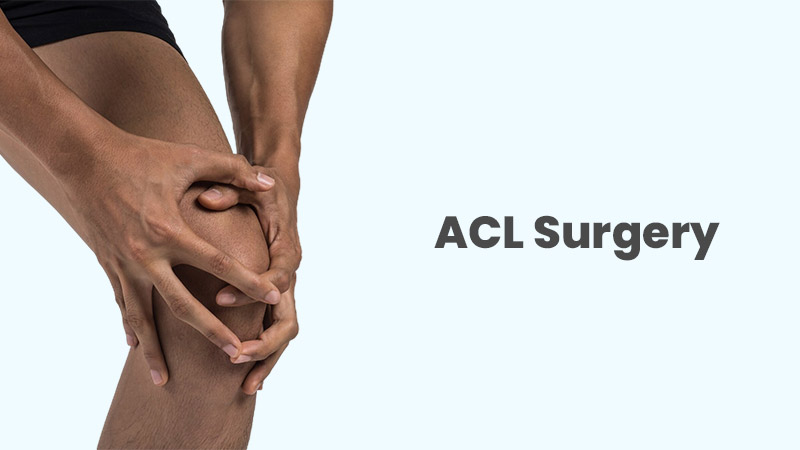
The anterior cruciate ligament (ACL) is a crucial component of the knee joint, providing rotational stability. When a forceful twist or hyperextension injures the ACL, it can lead to significant instability, pain, and difficulty participating in activities. Fortunately, with an ACL tear surgery at Kailash Hospital, you can restore knee stability and function and return to an active lifestyle.
Grafts We Use
A torn ACL cannot be effectively repaired by stitching it back together. ACL tear surgery, also known as ACL reconstruction, involves replacing the damaged ligament with a graft, a piece of tissue used to create a new ligament within the knee. The selection of graft material is influenced by various factors, including the patient's age, anatomy, and activity level. The three common grafts used by our surgeons are:
- Hamstring Tendon: This is the most common graft source, utilizing a tendon from the hamstring muscle group in the leg.
- Patellar Tendon: This graft uses a section of the patellar tendon, located just below the knee cap.
- Peroneus tendon: This graft can be harvested from ankle.
Symptoms of a torn ACL may include:
- Sudden, intense pain in the knee
- Swelling and inflammation
- Feeling of instability
- Difficulty bearing weight
Our Procedure
ACL reconstruction surgery is typically performed arthroscopically, a minimally invasive approach using a small camera inserted into the knee joint. The procedure includes:
- Preoperative Evaluation: This involves a thorough evaluation by our orthopedic surgeons. Our Knee surgeons will discuss your symptoms, medical history, and physical examination. Imaging tests like MRI scans will confirm the ACL tear and assess the surrounding structures.
- Preparation: On the day of surgery, our surgeons will instruct you to avoid eating or drinking for several hours beforehand.
- ACL Reconstruction Surgery: Our surgeons make small incisions around the knee. The arthroscope and surgical instruments are introduced through these small incisions. The surgeons will harvest the graft tissue, prepare the ACL attachment sites on the bones, and position the graft to create a new ligament. The graft is secured with screws or buttons. The entire procedure takes approximately 1 to 2 hours.
Following surgery, our acl orthopedic surgeons will bandage your knee and place it in a brace for stability. Physical therapy is crucial for regaining flexibility, strength and range of motion in the knee.
How long does recovery take after the surgery?
ACL surgery recovery is a gradual process, with significant pain relief often experienced within days. Routine work like attending office within 6 weeks but regaining full function can take months depending on the injury severity and your commitment to rehabilitation. Those who have undergone ACL repair surgery often regain the ability to participate in sports and other activities within 6–12 months.
After the surgery, our doctor will prescribe pain-relief medications. Exercises during the initial 7–10 days will focus on assisting the individual in straightening their leg. Applying ice to the joint regularly can help alleviate swelling and pain.
Our doctor will evaluate your capacity to bear weight on the injured limb and might suggest using crutches or wearing a knee brace. Individuals may resume light activities like walking and climbing stairs before swelling subsides and full strength is restored. Post operation exercises have a big role.
Benefits of ACL Tear Surgery
ACL tear surgery offers a multitude of benefits for anyone experiencing knee instability and dysfunction due to a torn ligament. These advantages include:
- Restored Knee Stability: The primary benefit is regaining stability in the knee joint, preventing excessive laxity (looseness) and reducing the risk of future injuries. This enables confident participation in activities involving pivoting, jumping, and sudden changes in direction.
- Improved Function: ACL reconstruction surgery helps restore normal knee function, allowing you to perform daily activities with greater ease and confidence. This can include walking, climbing stairs, squatting, and participating in sports.
- Reduced Pain: By addressing the underlying cause of instability and pain, ACL surgery significantly reduces knee discomfort, improving overall quality of life.
- Return to Activity: For active individuals, ACL reconstruction surgery is crucial for returning to sports participation. The restored stability and function allow athletes to perform at their pre-injury level with proper rehabilitation.
- Reduced Risk of Osteoarthritis: Early intervention with ACL surgery can help prevent the development of post-traumatic osteoarthritis, a degenerative joint disease that can occur due to chronic knee instability.
What are the possible complications after the surgery?
ACL tear surgery is a safe procedure and the associated complications are rare. Some potential complications of the surgery include -
- Knee stiffness
- Continued knee pain
- Bleeding and blood clots
- Infection
- Instability
Adhering to postoperative rehabilitation ensures a quick return to daily activities.
ACL Reconstruction vs Repair
It's important to distinguish ACL reconstruction from ACL repair. ACL repair involves stitching the torn ends of the original ligament back together. However, this approach is typically not recommended for ACL tears due to lower success rates compared to reconstruction with a graft.
When to consider ACL tear surgery?
You can talk to our orthopedic surgeon about ACL tear surgery, if you're experiencing sudden, intense pain in the knee along with swelling and inflammation. ACL tear surgery is a successful procedure for restoring stability and function in the knee following a ligament tear. By replacing the ACL with a graft and undergoing dedicated physical therapy, you can regain your active lifestyle and return to sports participation.
If you suspect an ACL tear, consult our orthopedic surgeons at Kailash Hospital to discuss the most suitable treatment approach for your specific needs.
Pacemaker Implantation
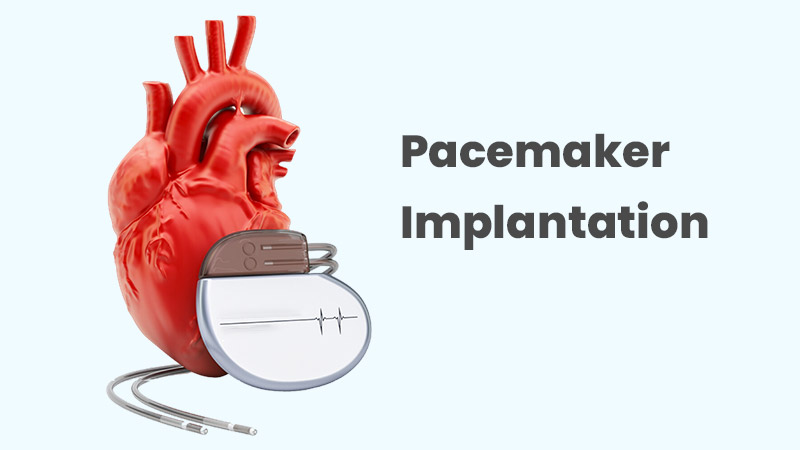
The heart, primarily a muscular pump, is regulated by electrical signals. Disruptions in these impulses can occur due to various factors, potentially resulting in serious heart conditions. Pacemaker implantation, a minimally invasive procedure, offers a life-saving solution for individuals with certain heart rhythm disorders.
What is Pacemaker Implantation?
Pacemaker implantation is a surgical procedure performed to implant a small electronic device called a pacemaker into the chest to regulate abnormal heart rhythms. This procedure is typically recommended for individuals with bradycardia (slow heart rate) or other cardiac arrhythmias that cannot be effectively managed with medication alone. The pacemaker monitors the heart's electrical activity and delivers electrical impulses to regulate the heartbeat as needed, ensuring that the heart beats at a normal rhythm.
Who Needs Pacemaker Implantation?
Pacemaker implantation is typically recommended for individuals experiencing heart rhythm disorders that significantly impact their health and well-being. Some common conditions prompting pacemaker implantation include:
- Bradycardia: A slow heart rate that can cause fatigue, dizziness, fainting, and even shortness of breath.
- Heart Block: A blockage in the electrical pathway of the heart, preventing normal signal transmission and leading to a slow heart rate.
- Syncope (Fainting): Episodes of fainting or near-fainting caused by a lack of sufficient blood flow to the brain due to an irregular heartbeat.
- Sick Sinus Syndrome: A condition where the heart's natural pacemaker (sinus node) malfunctions, leading to a slow or irregular heartbeat.
What are the Advantages of Pacemaker Implantation?
Pacemaker implantation offers several advantages, including:
- Regulation of Heart Rhythm: The pacemaker continuously monitors the heart's electrical activity and delivers electrical impulses to regulate the heartbeat, ensuring that it beats at a normal rhythm.
- Symptom Relief: Pacemaker implantation can relieve symptoms associated with bradycardia or other heart rhythm disorders, such as fainting, dizziness, fatigue, and shortness of breath, improving overall quality of life.
- Prevention of Complications: By maintaining a normal heart rate, pacemaker implantation can help prevent serious complications such as fainting spells or sudden cardiac arrest.
- Long-Term Management: With proper care and regular follow-up, a pacemaker can provide long-term management of heart rhythm disorders, allowing individuals to lead active and healthy lives.
The Pacemaker Implantation Procedure
Pacemaker implantation surgery is a relatively simple and safe procedure typically performed under local anesthesia. Here's a breakdown of the process:
- Pre-operative Evaluation: A thorough evaluation by a qualified pacemaker implant doctor in Noida is crucial. This involves discussing your medical history, symptoms, and medications. The doctor will perform a physical examination and order tests like electrocardiograms (ECGs) to assess your heart rhythm and determine the most suitable pacemaker type.
- Preparation: On the day of the surgery, you will likely be instructed to avoid eating or drinking for several hours beforehand. Medications might be administered to aid in your relaxation during the procedure.
- Implantation: A small incision is made in the chest area, usually near the collarbone. The doctor inserts the pacemaker and carefully positions the leads (thin wires) that connect the device to your heart muscle. The leads send electrical signals to help control your heartbeat. The procedure usually lasts between one and two hours.
- Recovery: Following the implantation, you will be monitored for a few hours to ensure proper functioning of the pacemaker. Recovery tends to be rapid, allowing most patients to return home within one to two days.
Living with a Pacemaker Implant
Pacemaker implantation surgery offers a significant improvement in quality of life for individuals with heart rhythm disorders.Here's what to expect after pacemaker implant surgery recovery:
- Activity Restrictions: Initially, your doctor might recommend certain activity restrictions to allow the incision to heal properly. Gradually, you can resume most normal activities.
- Follow-up Appointments: Regular follow-up appointments with your cardiologist are essential to monitor the pacemaker's function and make any necessary adjustments.
- Living a Healthy Lifestyle: Maintaining a healthy lifestyle with a balanced diet, regular exercise (as approved by your doctor), and managing stress can significantly contribute to your overall well-being.
Pacemaker implantation significantly impacts the lives of those with heart rhythm disorders. It offers a safe and effective way to regulate your heartbeat, significantly improving your quality of life and allowing you to live a more active and fulfilling life. If you are experiencing symptoms like fatigue, dizziness, or fainting, consult with a cardiologist near you to discuss whether pacemaker implantation could be the right option for you. Early diagnosis and treatment are crucial for managing heart rhythm disorders and ensuring optimal heart health.
Intra-Aortic Balloon Pump (IABP) Therapy
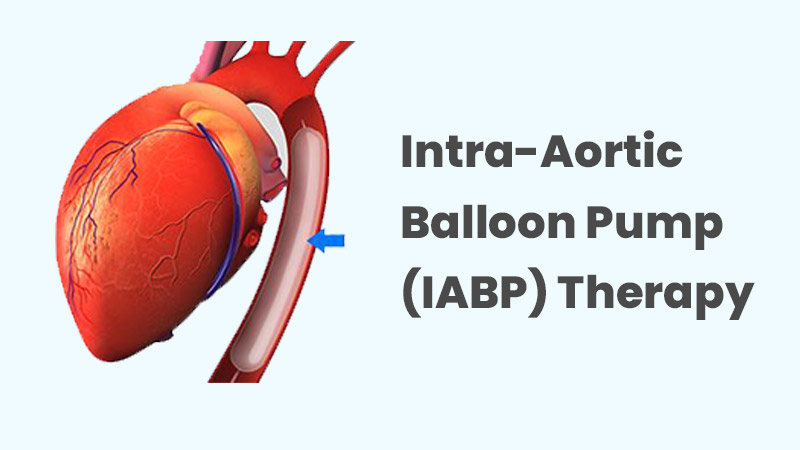
When the heart is severely damaged and cannot pump a sufficient amount of blood and oxygen to the body, an Intra-Aortic Balloon Pump (IABP) emerges as a vital support system. This innovative device serves as a temporary internal pump, aiding the heart in circulating blood more efficiently.
Understanding IABP Therapy
An Intra-aortic Balloon Pump (IABP) is a mechanical device used to support heart function and improve blood flow in patients with severe heart conditions, such as acute myocardial infarction (heart attack), cardiogenic shock, or heart failure. The IABP consists of a long, flexible tube (catheter) with a balloon attached to its tip, which is inserted into the aorta, the largest artery in the body. The balloon inflates and deflates in sync with the patient's heartbeat, helping to increase blood flow to the coronary arteries and reduce the workload of the heart.
How does the IABP Work?
The IABP works by inflating and deflating the balloon at specific times during the cardiac cycle. When the heart contracts (systole), the balloon deflates, allowing blood to flow more easily from the heart into the rest of the body. During relaxation (diastole), the balloon inflates, increasing blood flow to the coronary arteries and improving oxygen delivery to the heart muscle. This synchronized pumping action helps reduce the workload of the heart and improve cardiac function.
Who Needs IABP Therapy?
IABP therapy is typically employed for individuals experiencing conditions that compromise the heart's pumping ability. Some common scenarios where IABP might be recommended include:
- Cardiogenic Shock: A life-threatening condition where the heart weakens significantly, hindering its ability to pump blood adequately.
- Myocardial Infarction (Heart Attack): IABP can be used during or after a heart attack to support the heart muscle while it recovers.
- Cardiac Surgery: IABP can be used before, during, or after certain heart surgeries to provide temporary support for the heart.
- Valve Dysfunction: In some cases of severe valve problems, IABP can be used to bridge the gap until definitive treatment is performed.
The IABP Procedure
IABP insertion is a minimally invasive procedure usually performed in a critical care setting or catheterization laboratory. Here's a breakdown of the process:
- Pre-operative Evaluation: A thorough evaluation by a qualified healthcare professional is crucial. This involves discussing your medical history, symptoms, and medications. The doctor will assess your heart function and determine if IABP therapy is the most suitable course of action.
- Preparation: On the day of the procedure, you will likely be instructed to avoid eating or drinking for several hours beforehand. Medications might be provided to ensure you're relaxed during the heart balloon pump procedure.
- The IABP Procedure: A thin catheter is inserted by the doctor into an artery in your groin. Using X-ray guidance, the catheter is carefully threaded through the artery until it reaches the aorta. A small balloon at the tip of the catheter is then inflated and deflated in sync with your heartbeat using a synchronized console. Typically, the whole intra aortic balloon pump procedure is completed in under an hour.
- IABP Therapy Duration: The duration of IABP therapy varies depending on the underlying condition and your response to treatment. The duration usually varies from a few hours to multiple days.
Living with IABP Therapy
While IABP offers valuable support, it's a temporary intervention to assist the heart's pumping function. Here's what to expect:
- Activity Restrictions: Initially, you might have certain activity limitations to prevent dislodging the catheter. Gradually, you can resume most activities as tolerated.
- Monitoring and Care: Close monitoring of your vital signs, heart function, and the IABP system is essential throughout therapy.
- Addressing the Underlying Condition: IABP therapy buys time for the heart to recover or bridges the gap until definitive treatment for the underlying heart condition is addressed.
IABP therapy serves as a critical tool in supporting the heart during times of weakness or compromised function. By assisting blood flow and allowing the heart to rest and recover, IABP can significantly improve patient outcomes. Working closely with your healthcare team and addressing the underlying heart condition is crucial for long-term heart health.
Balloon Valvuloplasty

A narrowed heart valve can make it challenging to pump blood effectively throughout your body. This can lead to complications such as heart failure, blood clots, or stroke. Balloon valvuloplasty is a procedure that can help alleviate this condition. Balloon valvuloplasty offers a minimally invasive procedure to open narrowed heart valves, restoring proper blood flow and improving heart function.
Understanding Balloon Valvuloplasty
Balloon valvuloplasty is a catheter-based procedure used to widen narrowed heart valves. It's most commonly used for treating stenosis of the aortic valve (aortic valve stenosis) and the mitral valve (mitral valve stenosis). During the procedure, a thin, flexible tube called a catheter is inserted into a blood vessel in the groin or arm. The catheter is then guided to the narrowed valve using X-ray imaging. Once positioned, a small balloon at the tip of the catheter is inflated, pushing against the narrowed valve leaflets and stretching them open to improve blood flow.
Types of Balloon Valvuloplasty
- Balloon Aortic Valvuloplasty: The balloon aortic valvuloplasty procedure is used to treat aortic valve stenosis, a condition characterized by narrowing of the valve opening between the heart's left ventricle and the aorta.
- Mitral Valve Balloon Valvuloplasty: Mitral valve balloon valvuloplasty is performed to treat mitral valve stenosis, which occurs when the valve between the heart's left atrium and left ventricle narrows, restricting blood flow.
Who Needs Balloon Valvuloplasty?
Balloon valvuloplasty is typically considered for individuals experiencing symptoms of heart valve stenosis, such as:
- Shortness of breath: This can occur with exertion or even while at rest.
- Fatigue: Experiencing unusual tiredness and a lack of energy.
- Chest pain: Angina (chest discomfort) can occur with exertion.
- Palpitations: Experiencing a fluttering or rapid beating of the heart in the chest.
- Swollen ankles: Fluid buildup in the legs due to impaired heart function.
The Balloon Valvuloplasty Procedure
Balloon valvuloplasty is typically performed in a specialized cardiac catheterization laboratory within a hospital setting. Here's a breakdown of the process:
- Pre-operative Evaluation: A thorough evaluation by a qualified balloon valvuloplasty doctor is crucial. This involves discussing your medical history, symptoms, and medications. The doctor will perform a physical examination and order tests like echocardiograms (ultrasound imaging of the heart) to assess the severity of the valve stenosis and determine if balloon valvuloplasty is the most suitable treatment option.
- Preparation: On the day of the procedure, you will likely be instructed to avoid eating or drinking for several hours beforehand. Medications might be prescribed to help you relax during the procedure.
- The Balloon Valvuloplasty Procedure: The doctor inserts a catheter into a blood vessel in your groin or arm. The catheter is guided to the narrowed heart valve using X-ray imaging. The balloon at the catheter tip is then inflated to widen the valve. In some cases, additional procedures might be necessary depending on the specific situation. The procedure usually completes in one to two hours.
- Recovery: After the procedure, there will be a monitoring period of a few hours to check the blood flow and functionality of the valve that was treated. Balloon valvuloplasty recovery time is generally quicker compared to open-heart surgery, with most patients going home within a day or two.
Living After Balloon Valvuloplasty
While balloon valvuloplasty successfully opens narrowed valves, long-term management is crucial. Here's what to expect:
- Medication Management: Your doctor might prescribe medications to manage blood pressure, heart rhythm, or prevent blood clots.
- Regular Follow-up Appointments: Regular visits with your cardiologist are essential to monitor the valve function and potentially determine the need for future interventions.
- Healthy Lifestyle Choices: Maintaining a healthy diet, engaging in regular exercise (as approved by your doctor), and managing stress can significantly contribute to your overall cardiovascular health.
Balloon valvuloplasty offers a valuable minimally invasive option for individuals with narrowed heart valves. By widening the valve opening and improving blood flow, this procedure can significantly alleviate symptoms and improve heart function. However, it's important to remember that balloon valvuloplasty might not be a permanent solution, and the valve may narrow again over time. Working closely with your nearest heart specialist, adhering to a healthy lifestyle, and attending regular follow-up appointments are crucial for managing your heart health and maintaining optimal outcomes in the long run.
Automated Implantable Cardioverter Defibrillator (AICD)
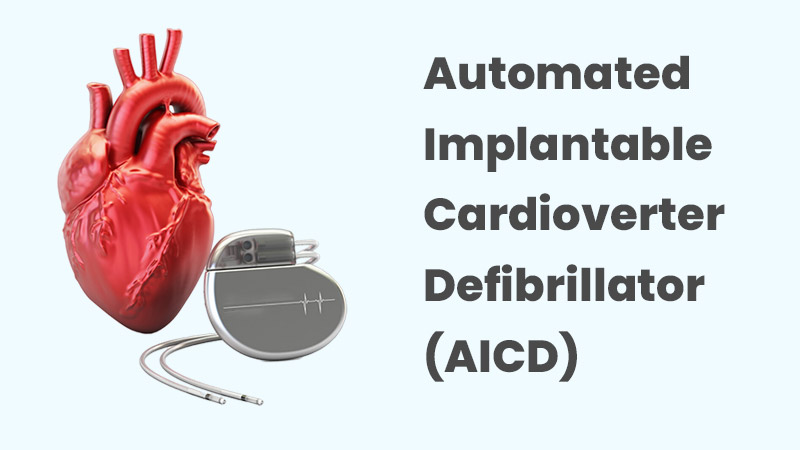
In a healthy state, the heart maintains a consistent, regular electrical rhythm. However, in certain individuals, this rhythm may become irregular, causing the heart to beat too quickly or too slowly. This irregularity is known as arrhythmia. An automated implantable cardioverter defibrillator (AICD) is a remarkable device that continuously monitors your heart rhythm and delivers a corrective electrical shock if a dangerous arrhythmia occurs.
What is an AICD?
An AICD, also known as an implantable cardioverter defibrillator (ICD) or Internal Cardiac Defibrillator, is a small, battery-powered medical device surgically implanted in the chest. It constantly monitors your heart rate and rhythm. If the AICD detects a dangerously fast or chaotic heartbeat (ventricular fibrillation or tachycardia), it delivers a low-energy electrical shock to reset the heart rhythm and restore normal function.
Who Needs an AICD Implantation?
AICD implantation is typically recommended for individuals with a high risk of sudden cardiac death due to specific heart rhythm disorders. These conditions can include:
- Ventricular fibrillation: A rapid and erratic quivering of the heart's lower chambers (ventricles), preventing effective blood pumping.
- Ventricular tachycardia: An abnormally fast heartbeat originating in the ventricles, potentially leading to ventricular fibrillation.
- Unexplained syncope (fainting): Episodes of fainting caused by a sudden drop in blood flow to the brain due to a severe heart rhythm abnormality.
- Wolff-Parkinson-White syndrome: A congenital heart condition that predisposes individuals to abnormal heart rhythms.
Your cardiologist will evaluate your medical history, symptoms, and diagnostic tests to determine if an AICD is appropriate for you.
The AICD Implantation Process
AICD implantation is a minimally invasive surgical procedure typically performed under local anesthesia. Here's a breakdown of the process:
- Pre-operative Evaluation: A thorough evaluation by a qualified ICD implant doctor in Noida is crucial. This involves discussing your medical history, symptoms, and medications. The doctor will perform a physical examination and order tests like electrocardiograms (ECGs) and echocardiograms (ultrasound imaging of the heart) to assess your heart function and determine if an AICD is the most suitable treatment option.
- Preparation: On the day of the surgery, you will likely be instructed to avoid eating or drinking for several hours beforehand. You might be given medications to aid relaxation during the procedure.
- Implantation: A small incision is made in the chest near the collarbone. The doctor inserts the AICD device and carefully positions thin wires (leads) connecting the device to your heart muscle. These leads transmit electrical signals for monitoring and potential shock delivery. The entire AICD procedure usually lasts between one and two hours.
- Recovery: Following implantation, you will be monitored for a few hours to ensure proper functioning of the AICD. Recovery is generally quick, and most patients can be discharged within one to two days.
Living with an AICD
An AICD implant or ICD implantation offers a significant improvement in security and peace of mind for individuals at risk of sudden cardiac death. Here's what to expect after AICD implant recovery:
- Activity Restrictions: Initially, your doctor might recommend certain activity restrictions to allow the incision to heal properly. Gradually, you can resume most normal activities.
- Regular Follow-up Appointments: Regular follow-up appointments with your cardiologist are essential to monitor the AICD's function and make any necessary adjustments. The doctor might also perform tests to ensure the leads are functioning correctly.
- Living a Heart-Healthy Lifestyle: Maintaining a healthy lifestyle with a balanced diet, regular exercise (as approved by your doctor), and managing stress can significantly contribute to your overall well-being and lower your risk of heart complications.
An AICD serves as a vital safety net for individuals at risk of life-threatening heart arrhythmias. By working closely with your cardiologist, adopting a heart-healthy lifestyle, and attending regular follow-up appointments, you can live a full and active life with the peace of mind that your AICD is there to protect you.
Angioplasty
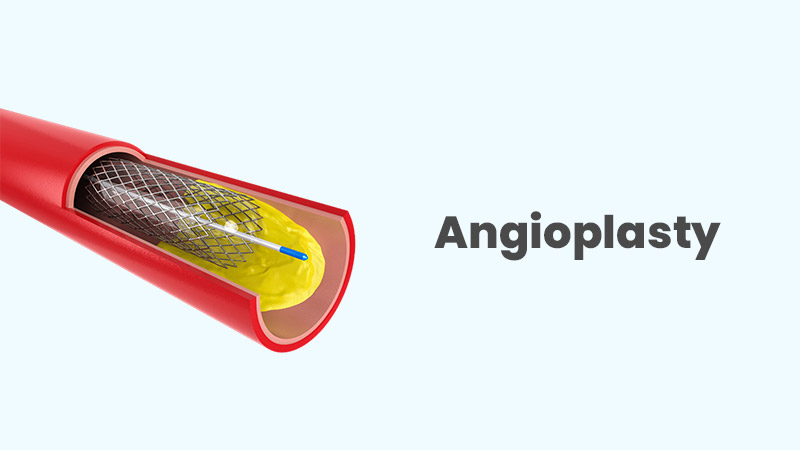
The human body is an intricate network, with our arteries serving as essential routes that transport oxygen-rich blood throughout our system. When these pathways become narrowed or blocked by plaque buildup (atherosclerosis), blood flow can become restricted, leading to a variety of health concerns. Angioplasty offers a minimally invasive procedure to restore blood flow and improve cardiovascular health.
Understanding Angioplasty
Angioplasty, also known as percutaneous coronary intervention (PCI), is a procedure that widens narrowed or blocked arteries in the heart. This is typically achieved by inserting a thin, flexible tube called a catheter into a blood vessel in the groin, arm, or wrist. Using X-ray imaging, the catheter is then guided to the blocked artery. Once in place, a tiny balloon at the tip of the catheter is inflated, pushing against the plaque buildup and widening the artery to improve blood flow.
Who Needs Angioplasty?
Angioplasty is often considered for individuals experiencing symptoms of coronary artery disease (CAD), such as chest pain (angina), shortness of breath, or fatigue. These symptoms arise due to the restricted blood flow to the heart muscle. Here are some common scenarios where angioplasty might be recommended:
- Angina: Chest pain that occurs with exertion and improves with rest.
- Atherosclerosis: Angioplasty is recommended if you have blockages in your coronary arteries.
- Heart attack: Angioplasty is performed during a heart attack to treat a blocked artery and minimize heart damage.
The Angioplasty Procedure
Angioplasty is typically performed in a specialized cardiac catheterization laboratory within a hospital setting. Here's a breakdown of the process:
- Pre-operative Evaluation: A thorough evaluation by a qualified angioplasty doctor in Noida is crucial. This involves discussing your medical history, symptoms, and medications. The doctor will perform a physical examination and order tests like electrocardiograms (ECGs) and coronary angiograms (X-ray imaging of the heart's arteries) to assess the extent of blockage.
- Preparation: On the day of the procedure, you will likely be instructed to avoid eating or drinking for several hours beforehand. You might be prescribed medications to help you relax during the procedure.
- The Angioplasty Process: The doctor inserts a catheter into a blood vessel in your groin, arm, or wrist. Using X-ray guidance, the catheter is navigated to the blocked artery. A small balloon on the catheter tip is then inflated to widen the narrowed artery. In some cases, a stent, a tiny mesh tube, might be placed within the artery to help it remain open. The entire procedure usually lasts between one and two hours.
- Recovery: Following the procedure, you will be monitored for a few hours to ensure proper blood flow and function of the treated artery. Most patients can be discharged within one to two days.
Lifestyle after Angioplasty
While angioplasty successfully opens blocked arteries, lifestyle modifications are crucial for long-term success. Here's what you can expect after angioplasty recovery:
- Medication Management: Your doctor might prescribe medications like aspirin, cholesterol-lowering medications, and blood thinners to prevent future blockages.
- Cardiac Rehabilitation: A personalized rehabilitation program can help you strengthen your heart and improve your overall fitness.
- Healthy Lifestyle Choices: Maintaining a healthy diet, engaging in regular exercise, and managing stress are essential for preventing future heart problems.
Angioplasty offers a valuable tool for restoring blood flow and improving heart health. By working closely with your doctor, adopting a healthy lifestyle, and adhering to prescribed medications, you can significantly reduce your risk of future heart complications and live a more fulfilling life.
Robotic Knee Replacement Surgery
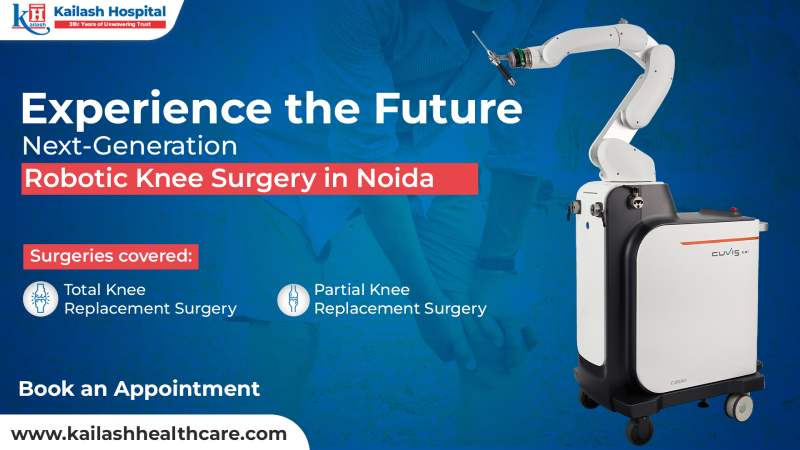
Modern technology has revolutionized healthcare in many ways, increasing accessibility to treatment and improving outcomes. Today, surgery has become more and more minimally invasive. Robotic systems are nowadays used across the globe for an expanding set of indications. Robotic knee replacement surgery has transformed the ever-evolving field of orthopedics, helping arthritis patients recover faster, with reduced pain, less blood loss, and shorter hospital stays.
What is Robotic Knee Replacement Surgery?
Knee replacement, though complex, is commonly performed in advanced arthritis cases. Surgeons now use minimally invasive techniques, computer assistance, and robotics for greater precision. Robotic assistance ensures precise joint fixation, reducing human error.
Robotic knee replacement surgery, also known as robotic knee arthroplasty, utilizes robotic technology to assist surgeons, improving accuracy and precision. It is a minimally invasive approach with potential for better outcomes.
During the procedure, the surgeon uses computed tomography (CT) scans to create a 3D model of the patient’s knee. With this model as guide, the robotic knee replacement surgeon uses the robotic arm to make accurate bone cuts and place implant components precisely.
Types of Robotic Knee Replacement Surgery
There are two main types of robotic knee procedures:
- Partial knee replacement: In this surgery, damaged cartilage and bone are removed and replaced only in one diseased compartment of the knee. It can provide relief from pain in people with early and mid-stage arthritis.
- Total knee replacement: Advanced arthritis affecting multiple compartments of the knee requires total knee arthroplasty.
How Does Robotic Knee Surgery Benefit Patients?
Robotic knee replacement procedure has many benefits for the patient. These include:
- Minimal Pain: Robotic surgery is less invasive than traditional procedures, which can result in smaller incisions, minimal trauma, reduced risk of infection, less pain and improved safety.
- Quick Recovery: Robotic assisted knee surgery provides up to 50% faster recovery time than other procedures. This means patients can be discharged early from the hospital and resume normal activities quickly.
- Improved Quality of Life: The fully automated system allows for more accurate placement of the implant, which can result in a more natural feel and improved function of the knee.
- Enhanced Implant Longevity: Due to the high precision, knee replacement can reduce the chance of implant failure or loosening, leading to a longer-lasting implant and improved function.
Who is the Right Candidate for Robotic Knee Replacement Surgery?
To be eligible for the procedure, your doctor might consider your age, lifestyle, damage to your knee joint and other factors.
- Pain caused by arthritis usually gets worse over time. If left untreated, it can even limit your range of motion. The most appropriate and long-lasting solution to arthritis is robotic knee replacement.
- Fully automated surgery can be used to treat complex degeneration of knee joints, any deformity following an injury or repair damaged implant from previous procedures.
- Candidates for robotic surgery are typically patients with severe pain in the joints and have not responded to conservative treatments.
- Candidates with good health at a suitable age are perfect candidates for surgery. The surgeon might not recommend the surgery to people who have crossed 65 years or with arthritis that has progressed aggressively.
Preoperative Evaluation For Robotic Knee Replacement
Before undergoing robotic knee replacement surgery, patients will undergo the following medical evaluation to determine if they are a candidate for the procedure.
- Review Medical history: The orthopedics surgeon will review the patients medical history, including any previous surgeries, medications, or medical conditions, to ensure that they are a suitable candidate for surgery.
- Physical examination: The surgeon will examine the joint to assess the extent of the damage. For this, the surgeon may assess the patients knee function, range of motion, and ability to perform daily activities.
- Imaging tests: Imaging tests such as X-rays, MRI scans, or CT scans may provide detailed images of the knee joint and surrounding structures.
- Laboratory tests: Lab tests such as urinalysis, electrocardiography and blood tests may be done to assess the patients overall health.
Recovery Process Following Surgery
The recovery process after robotic knee replacement surgery can vary from person to person. However, most patients can expect to stay in the hospital for a few days following surgery and will begin physical therapy soon after to help regain strength and range of motion in the knee.
Patients will have follow-up appointments with their surgeon to monitor their progress and to address any concerns or questions they may have. It typically takes about three to six weeks to regain mobility.
Care After Knee Surgery
Some common aftercare practices include:
- Taking pain medication as prescribed by the surgeon to manage post-operative pain.
- Attending physical therapy sessions as recommended by the surgeon.
- Avoiding high-impact activities or heavy lifting for the first few weeks after surgery.Gradually increase the activity level as directed by the surgeon.
- Attending all follow-up appointments with the surgeon to monitor progress and address any concerns or questions you may have.
Is Robotic Knee Replacement Surgery Better Than Traditional Procedure?
While traditional knee replacement surgery has been a successful treatment option for many years, robotic knee surgery offers several advantages. Here are a few reasons why one might consider opting for fully automated surgery.
- Minimally invasive approach:Unlike traditional methods, robotic surgery uses a minimally invasive approach with smaller incisions.
- Enhanced surgery planning:The specialized 3D images help the surgeon more accurately plan the optimal type and placement of the artificial joint components.
- Personalized adjustments:Automated systems enable knee surgeons to create a personalized treatment plan based on the individuals specific anatomy.
- Precise positioning: The robotic arm used during the surgery allows for more precise implant placement, leading to better implant alignment, fewer complications and better long-term outcomes.
- High Accuracy:Compared to traditional methods, robotic arms have better accuracy and give a more natural feeling post surgery.
- Better Patient Outcome:Patients receiving robotic knee surgery require less rehabilitation. Also, many patients report a natural feel, improved knee function and reduced pain following the treatment.
- Increased Safety:With smaller incisions, there is less trauma to the surrounding tissues. Also, there is a potentially reduced risk of implant loosening, instability or dislocation over time as the implants are aligned carefully.
FAQ'S
If you suffer from chronic knee pain, stiffness, and reduced mobility that interferes with daily activities despite medication or therapy, your doctor may recommend surgery.
Most patients stay in the hospital for 3 to 5 days, depending on recovery speed and the type of procedure performed.
Patients are encouraged to walk with assistance (like a walker) within a day after surgery under medical supervision.
Yes, bilateral knee replacement is an option for some patients, but the decision depends on overall health and fitness.
In the initial recovery phase, help with daily tasks is often needed. A physiotherapist may also visit for at-home sessions.
Kailash Hospital provides expert orthopedic surgeons, advanced surgical technology, and comprehensive rehabilitation services for faster, safer recovery.
FAQ'S
Persistent hip pain, stiffness, limited mobility, and difficulty in walking or climbing stairs, especially after non-surgical treatments have failed, could indicate the need for hip replacement.
Yes, hip replacement is commonly performed on elderly patients and has a high success rate in restoring mobility and reducing pain when managed by expert orthopedic surgeons.
Modern implants typically last 15 to 20 years or longer with proper care, though longevity can vary based on activity level and health.
Most patients begin walking with assistance within 24 to 48 hours post-surgery, under the supervision of a physiotherapist.
Yes, a structured rehabilitation program is essential to regain strength, flexibility, and balance in the hip joint.
Kailash Hospital offers advanced orthopedic care with expert joint replacement surgeons, cutting-edge operation theatres, and personalized recovery plans.
FAQ'S
If shoulder pain limits daily activities, doesn’t improve with treatment, or causes joint stiffness, surgery might be necessary.
Most shoulder replacements last 15-20 years, depending on activity levels and proper care post-surgery.
Yes, Physiotherapy is crucial for restoring mobility and strengthening the shoulder joint after surgery.
With your doctor's guidance, many low-impact activities like swimming or golf can resume within a few months post-surgery.
Pain is managed effectively with modern anesthesia and post-operative medications. Pain usually decreases significantly within weeks.
Complications like infection, nerve damage, or joint stiffness are rare but possible. Choosing an experienced surgeon minimizes these risks.
It depends on the job. Desk jobs may resume within 4-6 weeks, while physically demanding work might take longer.
FAQ'S
Severe pain, swelling, difficulty moving the affected area, or symptoms that persist despite rest indicate the need for professional care. Visit Kailash Hospital for an accurate diagnosis.
Treatment can range from rest and physiotherapy to medications and surgery for severe cases. Kailash Hospital offers personalized plans for effective recovery.
Minor injuries may heal with rest and care, but ignoring persistent issues can lead to complications. Early intervention ensures quicker recovery and prevents long-term damage.
Recovery time depends on the type and severity of the injury, ranging from days for minor strains to months for more severe cases. Your doctor at Kailash Hospital will provide a specific timeline.
Not all injuries need surgery. Many can be treated with non-invasive methods like physiotherapy or injections. Kailash Hospital evaluates each case individually to recommend the best course of action.
Avoid strenuous activities, overexertion, and returning to sports too soon. Following your doctor’s advice ensures a smooth recovery.
Most insurance plans cover treatment for sports injuries. The team at Kailash Hospital can assist in understanding your coverage and processing claims.
FAQ'S
You may need knee replacement if you experience constant knee pain that limits daily activities, discomfort during rest, or significant stiffness and swelling. A consultation at Kailash Hospital can help determine if surgery is the right option.
The procedure typically lasts one to two hours, depending on the specifics of the case. Your surgeon at Kailash Hospital will provide a more accurate estimate based on your condition.
Some discomfort is expected after surgery, but pain management strategies and physical therapy help manage it effectively. Kailash Hospital’s team will provide a recovery plan tailored to reduce pain.
Yes, both knees can be replaced in one session, though it depends on your health and preferences. Your doctor at Kailash Hospital will discuss whether this option is suitable for you.
Patients with desk jobs can typically return to work in six to eight weeks, while physically demanding jobs may take longer. Kailash Hospital will guide your recovery to ensure a safe return to normal activities.
A new knee joint usually lasts 15–20 years or more with proper care. Following healthy habits and regular check-ups can help extend the lifespan of your joint.
Non-surgical options like physical therapy, injections, and medications can help in early stages. If pain remains severe, total knee replacement might be the most effective solution, which your doctor at Kailash Hospital can discuss.
FAQ'S
Ankle arthroscopy can address ligament tears, bone spurs, cartilage damage, and chronic pain.
Typically, the procedure lasts between 30 minutes to 1 hour, depending on the complexity of the condition.
Yes, most ankle arthroscopy surgeries are outpatient, allowing patients to return home the same day.
Walking with support, such as crutches, is usually possible within a few days, as directed by your doctor.
Most patients can resume normal activities within a few weeks, though high-impact sports may require a longer recovery period.
The procedure is typically performed under general or regional anesthesia to ensure comfort.
Elevate your foot, apply ice packs, and follow your doctor’s instructions for optimal recovery.
FAQ'S
An ACL tear commonly occurs due to sudden stops, changes in direction, or awkward landings during sports activities. It can also result from direct impacts to the knee, such as those experienced in car accidents or falls.
An ACL tear is typically diagnosed through a combination of physical examination, patient history, and imaging tests such as MRI. The Lachman test, pivot shift test, and anterior drawer test are specific maneuvers used by doctors to assess ACL integrity.
Partial ACL tears or those involving less active individuals may sometimes be managed non-surgically with physical therapy and bracing. However, complete tears in active individuals or those experiencing significant instability usually require surgical intervention for optimal recovery.
ACL reconstruction can use autografts (patient’s own tissue) or allografts (donor tissue). Common autografts include hamstring tendon, patellar tendon, and quadriceps tendon. The choice of graft depends on patient factors and surgeon preference.
In the first few weeks after ACL surgery, patients can expect swelling, discomfort, and limited mobility. Crutches are typically used to assist with walking, and physical therapy begins early to promote healing and restore movement.
During the recovery period, patients should avoid activities that place excessive stress on the knee, such as running, jumping, and pivoting movements. High-impact sports should be avoided until the knee is fully healed and cleared by the surgeon.
Preparation for ACL surgery involves pre-operative physical therapy to strengthen the surrounding muscles, cessation of certain medications that may affect healing, arranging post-operative care and support, and following the surgeon's specific pre-surgery instructions for fasting and medication adjustments.
FAQ'S
A pacemaker is a small device that helps regulate the heart’s rhythm by sending electrical impulses to ensure the heart beats normally.
It is typically recommended for people with arrhythmias or heart conditions causing irregular heartbeats or a slow heart rate.
The procedure involves placing the pacemaker under the skin near the collarbone and connecting leads to the heart through a vein.
The procedure is performed under local anesthesia, so patients usually experience almost no discomfort during the implantation.
A pacemaker typically lasts between 5 to 15 years, depending on the type and how often it is used.
Patients should avoid heavy lifting or strenuous activities for a few weeks and follow up with their doctor to monitor the pacemaker’s function.
Most people can return to normal activities, but they should avoid strong magnetic fields, and some medical devices may need special precautions.
FAQ'S
It helps the heart pump blood more effectively and reduces strain on the heart.
It is used in cases of severe heart failure, after a heart attack, or during high-risk cardiac procedures.
The balloon catheter is placed in the aorta through a small incision, usually in the groin area.
Movement is limited to ensure the balloon stays in the correct position during treatment.
It is usually a temporary device, used for a few hours to a few days, depending on the patient’s condition.
Patients may feel mild discomfort during insertion, but sedation and anesthesia minimize pain.
After removal, patients are monitored closely for a short period to ensure stable heart function.
FAQ'S
It treats narrowed heart valves (stenosis) by widening the valve opening to improve blood flow.
The procedure typically lasts about 1-2 hours, depending on the complexity of the condition.
While it provides significant relief, the valve may narrow again over time, requiring further treatment.
Yes, it is usually performed under local anesthesia with sedation to keep the patient comfortable.
Most patients recover within a few days but may need a week of rest before resuming normal activities.
Yes, it is often recommended for both younger and older patients with valve narrowing issues, depending on individual health needs.
Many patients feel relief from symptoms like breathlessness and fatigue within a few days after the procedure.
FAQ'S
An AICD monitors heart rhythms and delivers shocks to restore normal rhythm if a life-threatening arrhythmia occurs.
Yes, an AICD is implanted permanently, but its battery may need replacement every 5-10 years.
Recovery typically takes 4-6 weeks, during which strenuous activities should be avoided.
Most devices are safe, but you should avoid prolonged close contact with strong magnets or electromagnetic fields.
No, it only activates if it detects dangerous arrhythmias, otherwise, it remains inactive.
A small bulge may appear under the skin at the implant site, usually near the chest.
Yes, periodic checkups ensure the device functions correctly and adjusts to any changes in your condition.
FAQ'S
Angioplasty restores blood flow by opening narrowed or blocked arteries, improving heart function.
Angioplasty is less invasive, using a catheter to clear blockages, while bypass surgery involves creating new routes for blood flow.
Most patients stay 1-2 days, with some discharged the same day if no complications arise.
Patients are advised to eat a heart-healthy diet, avoiding fatty and processed foods to maintain artery health.
The procedure typically lasts 30 minutes to 2 hours, depending on the complexity of the blockage.
While angioplasty improves blood flow, lifestyle changes and medications are necessary to prevent new blockages.
The procedure itself is painless due to anesthesia, though some mild discomfort may occur during catheter insertion.
FAQ'S
The lifespan of a knee implant can vary depending on several factors, including the type of implant used, the patients activity level, and their overall health. In general, most knee implants can last 15-20 years or more.
The length of hospital stay after surgery can vary based on the extent of the surgery and how well you are recovering. In general, most patients can expect to stay in the hospital for one to three days following surgery.
Robotic knee replacement does not mean a robot is doing the surgery. A robotic arm assists the surgeon to perform the procedure with greater precision.
The duration of robotic knee replacement surgery can vary depending on the complexity of the procedure and the patients anatomy. In general, the surgery can take anywhere from one to three hours.
The timeline for returning to normal activities after surgery can vary. In general, most patients can expect to return to light activities within a few weeks and resume normal activities within a few months.
Physical therapy is an important part of the recovery process after surgery. It improves strength, flexibility, and range of motion in the knee and can help you regain function and mobility more quickly.
Related Blogs
Patient Reviews & FeedBack
© 2025 Kailash Healthcare Ltd. All Rights Reserved





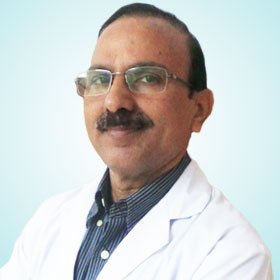
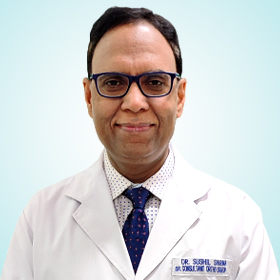


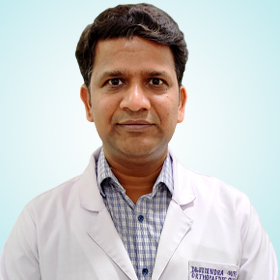



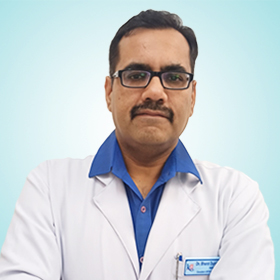

.jpg.jpg)
